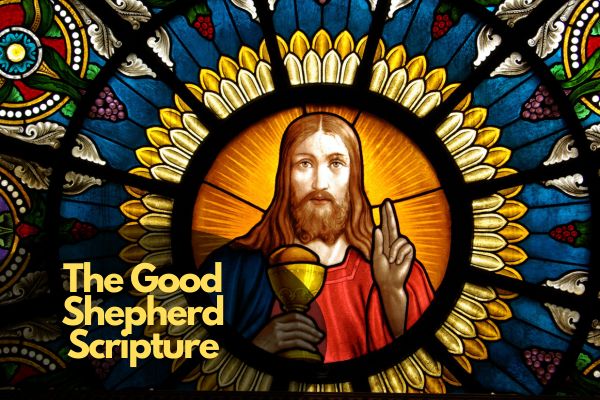The Good Shepherd Scripture is a profound and timeless passage found in the New Testament of the Bible. It is a metaphorical representation of Jesus Christ as the caring and protective shepherd, guiding and watching over his flock.
This scripture, often referred to as the Good Shepherd parable, holds deep spiritual significance and offers insights into the nature of Jesus’ love, compassion, and sacrifice.
In this article, we will explore the meaning and symbolism behind the Good Shepherd Scripture, looking into its historical context and its relevance in our lives today.
The Good shepherd scripture
The Good Shepherd Scripture uses powerful imagery to convey spiritual truths. Jesus, as the Good Shepherd, represents God’s love and guidance for humanity. He knows each of his sheep individually, demonstrating an intimate relationship with his followers.
The sheep symbolize believers, who recognize and trust the voice of their Shepherd. They find safety and nourishment under his watchful care. The Good Shepherd’s willingness to lay down his life for his sheep illustrates Jesus’ sacrificial love, as he ultimately gave his life on the cross for the redemption of humanity.
The Good Shepherd Scripture is primarily found in the Gospel of John, Chapter 10, verses 1 to 18. It begins with Jesus describing himself as the gate for the sheepfold, emphasizing that those who enter through him will find salvation and eternal life.
Jesus further explains that he is the Good Shepherd who cares for his sheep, calling them by name and leading them to green pastures. The Good Shepherd is contrasted with hired shepherds who do not have genuine concern for the sheep and may abandon them in times of danger.
Historical and Cultural Context
To appreciate the significance of the Good Shepherd Scripture, it is helpful to understand its historical and cultural context. In biblical times, shepherding was a familiar occupation, and people were acquainted with the responsibilities and challenges it entailed. Shepherds were responsible for the well-being of their flock, protecting them from predators, guiding them to safe pastures, and tending to their needs. By using this familiar imagery, Jesus effectively communicated his role as the caring and devoted shepherd of his followers.
Other Biblical Interpretation
Psalms 23:1-4: The 23rd Psalm is a poetic masterpiece that vividly portrays the Lord as the ultimate shepherd. The opening verse sets the tone: “The Lord is my shepherd; I shall not want.” Here, the shepherd is not just a provider but a source of complete fulfillment, ensuring the well-being of the believer.
Ezekiel 34:11-16: In Ezekiel, the shepherd metaphor takes on a communal dimension. The Lord is portrayed as the shepherd who actively seeks out His scattered flock. This passage emphasizes God’s commitment to caring for each individual within the larger community, reinforcing the idea of divine guidance and protection.
Hebrews 13:20–21: In the Book of Hebrews, the shepherd metaphor is extended to describe Jesus as the great shepherd of the sheep. The passage invokes the idea of an eternal covenant and the working of God within the believer. The shepherd is not only a guide in earthly matters but also a source of spiritual transformation, equipping the flock for every good work.
Relevance Today
The Good Shepherd Scripture continues to resonate with believers today, offering comfort, assurance, and guidance. It reminds us that we are not alone in our journey through life. Jesus, our Good Shepherd, is always present, guiding, protecting, and providing for us. His voice calls us to safety, direction, and spiritual nourishment. In a world often filled with uncertainty and turmoil, the Good Shepherd Scripture assures us of God’s unwavering love and care.
Challenges and Criticisms
Cultural Variations and Interpretation Challenges: One significant challenge lies in the diverse interpretations shaped by cultural differences. The shepherd metaphor originates from an ancient, agrarian society, and its relevance may be less apparent in contemporary urban cultures.
Evolving Perspectives on Biblical Metaphors: As societal attitudes and beliefs evolve, so do interpretations of biblical metaphors. Critics argue that the shepherd metaphor may be viewed as outdated or simplistic in the face of modern complexities.
Misuse of the Shepherd Metaphor: Critics point to instances where the shepherd metaphor is misused or exploited for personal gain. Whether in the hands of charismatic leaders or within specific religious contexts, there’s a risk of manipulation or misrepresentation.
Conclusion
The Good Shepherd Scripture serves as a powerful reminder of Jesus’ unwavering love and care for humanity. It teaches us that we are not alone in our journey through life, for the Good Shepherd is always with us, ready to guide, protect, and provide for us. It highlights the profound sacrifice Jesus made for the sake of his flock, laying down his life so that we may have eternal life.
As we reflect on the Good Shepherd Scripture, may we find comfort, strength, and inspiration in knowing that we are cherished and watched over by the one who knows us intimately and loves us unconditionally. May we strive to follow the example of the Good Shepherd, extending compassion, care, and selflessness to others, as we walk in the light of his eternal love.






